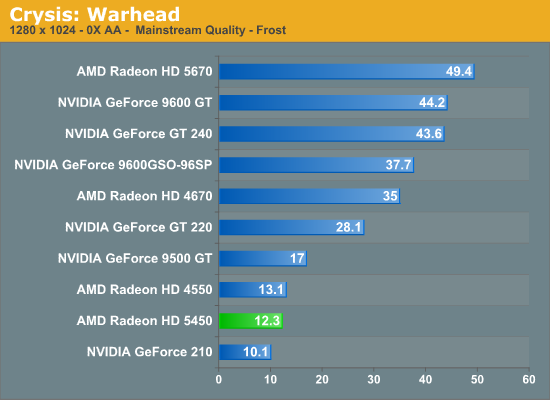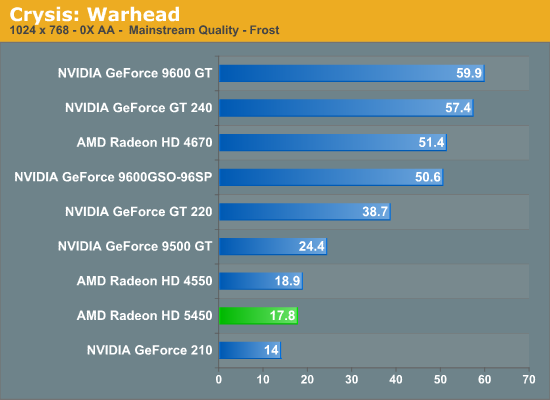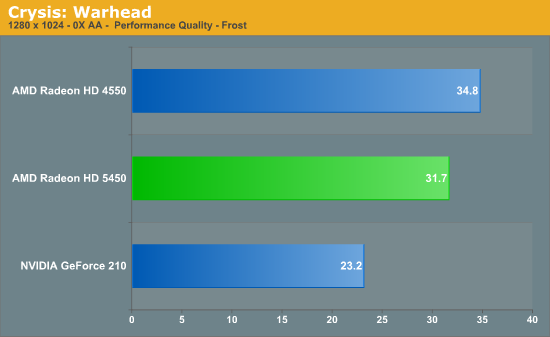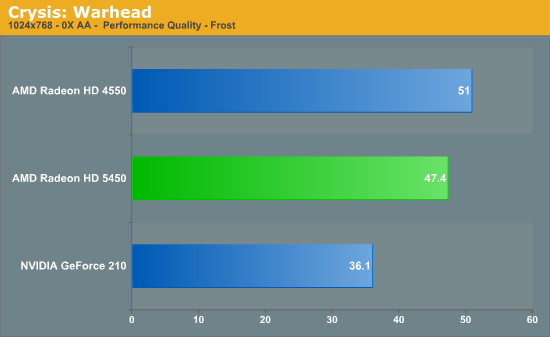AMD’s Radeon HD 5450: The Next Step In HTPC Video Cards
by Ryan Smith on February 4, 2010 12:00 AM EST- Posted in
- GPUs
Crysis: Warhead
We’ll start with Crysis: Warhead, one of our most demanding games.


The 80% reduction in shader units from the 5670 becomes apparent quickly here, as the 5450 and comparable cards are all in the teens for a framerate. This puts us at 75% below the 5670, and even compared to the GT220 the 5450 is still less than half as fast. Even with these already lower settings, we’re going to have to go lower yet to get playable framerates. This will set the stage for the entire review.












77 Comments
View All Comments
andy o - Thursday, February 4, 2010 - link
So far the most reasonable explanation I've seen by googling is someone if a forum suggesting that its function is just disabling certain features so as to prioritize smooth playback over those features. I don't see any difference with the 5770, otherwise (with that card it doesn't disable anything).UNCjigga - Thursday, February 4, 2010 - link
I sort of assumed it was similar to what 120hz/240hz LCD TVs do: use a frame doubler to more closely match your monitor's refresh rate and give the impression of "smooth" motion.andy o - Thursday, February 4, 2010 - link
I don't think so, most PC displays are 60 Hz, and I think even most 120 Hz TVs only take up to 60p input. There's only a couple of 120Hz-input monitors.therealnickdanger - Wednesday, February 10, 2010 - link
Actually, most CRTs using analog connections are capable of 120Hz. DVI, HDMI, and DisplayPort do not support digital transmission speeds over 60Hz. It's a sad state of affairs if you ask me.sc3252 - Thursday, February 4, 2010 - link
I know this isn't exactly supposed to be a fast card, but its clocked ~10% faster yet its slower than the last generation card... I can't say I am surprised though, after seeing the 5770 clocked faster than the 4870 yet being around the same speed.StevoLincolnite - Thursday, February 4, 2010 - link
I think people are missing allot of the big picture here and that's Crossfire with the Radeon 54xx series.Specifically with the new 8 series of chipsets, hence the amount of shaders present, I expect a return of Hybrid Crossfire.
Pairing an IGP with a low-end card is a very cost effective solution to getting more performance out of a system and also gives AMD an edge in getting more people to buy an AMD Processor+Chipset+Graphics card.
ereavis - Thursday, February 4, 2010 - link
"me too" I'd dig a 758G Hybrid Crossfire review with this and the other sub $100 Radeons (if they support x-fire) 785 was a great motherboard to match with the Athlon II and Phenom II X2-X3, some of us were waiting on video card purchases and would like to see Crossfire 54XX/56XX compared to a 5750 discrete for example.JarredWalton - Friday, February 5, 2010 - link
Fun fact: HD 5450 is about 40% faster than my pathetic old 7600 GT in my work PC. Remember when 6600 GT was da bomb? LOLQuietOC - Thursday, February 4, 2010 - link
The 80 shader discrete Radeons are just too limited by 64-bit DDR3. The 785G has more bandwidth and the same number of ROPS (mine even runs fine at 1GHz.) If they had cut the power usage of the 5450 down a lot more it may have made some sense.Totally - Thursday, February 4, 2010 - link
5770 128-bit bus, 4870 256-bit busagain 5450 64-bit bus, 4550 128-bit bus